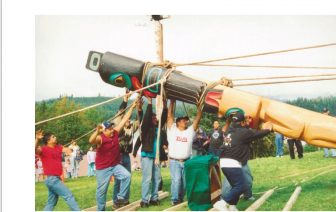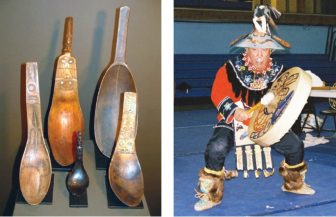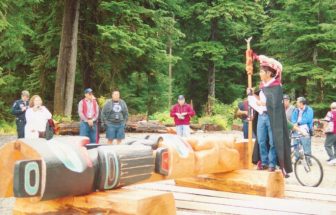In the beginning of “the people,” the commensality and feasting had birthed a social mechanism, a central theme in our evolving society. Within cultures, the hearth symbolizes “welcome.” A feast is a celebration with foods, perhaps served only for the occasion, in unique and sacred containers. There may be gift giving either with or without a contractual obligation. Anthropomorphic, carved figures may be displayed either within the feasting area or outside, to welcome the guests. Name giving has been an important part of feasts by some cultures, like the tribes on the northwestern coast of the United States, carrying on the potlatch tradition.
 Makah red cedar carving by Youngdoctor, circa 1890s, containing original polychrome pigments. This type of carving would be displayed during a feasting occasion.
Makah red cedar carving by Youngdoctor, circa 1890s, containing original polychrome pigments. This type of carving would be displayed during a feasting occasion.
Left to right: Back row—wooden Tlingit spoon with inlaid with abalone; wooden Pacific Eskimo spoon. Front row—wooden Tlingit spoon; small dark spoon of a northwest origin; Tlingit horn spoon.
Tlingit dancer Tootsie-a-‘Kea-Tiny Barril performing an “entrance dance” at Tom Dalton’s 2005 Tlingit Potlatch, Tulalip, Washington.
As feasts evolved, rituals became attached, which signified the type of feast being held. Soon, these feasts became more complex, expanding into festivals involving specific etiquette, which molded community behavior. Feasts and festivals proliferated and assimilated cultures by blending rituals, as occurred with the early  Christian and Roman observances, such as the creation of Christmas from the solstice celebrations. Could our very political system stem from the act of feasts and festivals? This is the question Michael Dietler and Brian Hayden pose in their analysis Feasts: Archaeological and Ethnographic Perspectives on Food, Politics, and Power (2001). How was surplus food used to start creating feasts and thus preserve the etiquette revolving around the display of finely crafted property appropriate to ensure survival of these mores?
Christian and Roman observances, such as the creation of Christmas from the solstice celebrations. Could our very political system stem from the act of feasts and festivals? This is the question Michael Dietler and Brian Hayden pose in their analysis Feasts: Archaeological and Ethnographic Perspectives on Food, Politics, and Power (2001). How was surplus food used to start creating feasts and thus preserve the etiquette revolving around the display of finely crafted property appropriate to ensure survival of these mores?
What new feasts and festivals will be created in the future? As modern indigenous peoples are rediscovering their ancient pasts, will there once again be a revival of ancient rituals, perhaps returning to a moral universe, where Raven rules within his potlatch?
Feasts can be put into three categories:
- Long-Term-Goal Feast: There is a definite plan in this type of feast, such as to solidify alliances, to bring about peace, to settle disputes, or to raise the status of a chief’s child.
- Symbolic Feast: There may be underlying goals in this feast, such as occur at a funeral feast to demonstrate future leadership. These feasts are usually sacred in character, such as memorial or marriage feasts, the first harvest, honoring the ancestors, births, adoptions, and rites of passage.

- Immediate-Goal Feast: This is more of an impromptu feast and may not have any ritual foods connected with it. This may be a crisis or work feast, or perhaps when a judgment needs to be made or during the planning of potlatch.
Evolution of Feasting
Feasts are speculated to have originated prior to Paleolithic man. Hunting-and-gathering tribes were usually nomadic in nature and would call a feast with the advent of any sudden abundance of food. A case in point is the system of distribution among the Inupiat and Nootka Peoples. When a whale is taken, after a feast is held, the entire clan receives shares. The Inupiat call this the nalukataq, and in ancient times, this would last nearly a week and would signify the cessation of whaling. Nomadic peoples lacked the ability to store surplus food required for a large feast; consequently, these may have been started by seminomadic, transegalitarian tribes.
Gender reinforcement is visible in ancient feasts, as most often the females prepared and served the feasts, although historically, handicapped males would also take part in what was thought to be “women’s work.” The males did the hunting and developed their prowess and status as a result of their success and leadership positions. Some tribes observed a strict etiquette regarding certain foods; for example, the Koyukon distinguished between feasting on black and brown bear meat. The first feast was held by the hunters within the forest, to honor the bear’s spirit. The “best parts” of the meat were saved for the potlatch, and then cooked only by men. Adults have encouraged children to partake in feasting rituals in the past as Franz Boas (1858-1942), discovered among the Kwakiutl.
Various Rituals Observed
Beginning rituals would involve thanking the animal or Creator for bringing food to the clan. While doing
his study on Huna seagull egg gathering in 2003, Eugene S. Hunn was told to “have respect for everything” concerning the ritual of food gathering. Fasting may be observed in the beginning phases of a religious purification feast. A sacramental communal feast may be a totem feast, where the clan joins in eating the totem object (salmon or bear, for example) as the totem’s “power” is consumed, renewing the person’s individual connection with that power. Rituals have taken the form of dancing and singing, such as the Feast of the Dead, witnessed by Ernest Hawkes, in 1914, where the “Feast Giver” honored a departed loved one by dancing and wearing the clothes representing the gender of the departed relative.
 Brown Bear totem raising at Klawock Totem Park, 2003. Master Carver John Rowen in the center wearing a white shirt.
Brown Bear totem raising at Klawock Totem Park, 2003. Master Carver John Rowen in the center wearing a white shirt.
Traditional oratory was important to the Tlingit People, as is set forth in the oral tradition recorded among the Tlingit by Nora and Richard Dauenhauer, in their traditional research entitled Haa Tuwunaagu Yis: for Healing our Spirit (1990). Because there was no written record, public speeches were given to reaffirm the owner’s rights to inherited privileges and property. The Bella Coola, as other Northwest cultures, have utilized this time to bring honor to their given traditional family names and also to bestow revered names upon their children and those they adopt. Attendees witnessing these privileges are paid rich and elaborate gifts to remember the name, meaning, and history. Smoking has been part of some feasting rituals, as was observed by the Tlingits; they put tobacco in the fire while respectfully uttering the names of the deceased being honored, before smoking their native tobacco in their world-renowned and elaborately carved pipes.
Status reserved seating was observed in nonegalitarian societies, as was the displaying of valuables. The northwestern coast Natives observed a ritual of honoring the fish by returning the bones of the first catch to the water, to ensure future fish runs. With the Koyukon, honoring ceremonial animals took the form of a ritual, to return the bones of water creatures to the water and bones of land creatures to the land. These rituals were based on the belief; it was the choice of the animals, fish, and fowl as to whether they wanted to be human food, depending on how they were honored.
There may be specialized structures built or made for feasting, such as the Inuit circular-stone seating arrangements, which stand out in their Arctic homeland and served not only as an area for feasts, but also for courts of judgments, as photographed by Norman Hallendy in 2000. In a dramatic ritual among the Inupiat at the Bering Strait, ceremonial items may be destroyed at the end of the festival, and at this time, masks may be thrown into the sacrificial flames. The Tlingits, Haidas, and Kwakiutl have been known to burn canoes, throw copper shields in the water (also known as “drowning the copper”), kill slaves, and tear blankets during their feasts.
Festivals
As rituals and customs evolved within feasts, festivals began to emerge. A festival usually accommodated more than one feast that observed set rituals. Alliances were often required from all of the kinsmen to prepare for a festival, with the lower caste doing most of the production and food gathering, including the exploitation of slaves. Seminomadic tribes or bands started developing festivals, such as the Inupiat with their “traditional trading fair,” held in the summer, where bands of Inupiat gathered to trade, visit, and feast.
The host, in observing said rituals (e.g., to honor the ancestors), may also serve to benefit that person or clan by raising their status to ensure a greater return, as in a competitive potlatch or the Inupiat’s “Great Feast of the Dead.” It would take years for both parties to gather wealth for distributing the gifts, at which the receivers assumed a contractual obligation to give as many, if not more, gifts in return at their feasting occasion. When the potlatch was banned in Canada in 1885, many hosts who gave away much wealth (e.g., rifles, pool tables, sewing machines, and so on) were never repaid, thus experiencing a great loss; but since the host takes on the “superior” status in outdoing his peers if he is not repaid, then at least that status remains.
Continuing Traditions
The act of feasting and of festivals is a long-standing tradition with humankind. The development of these occasions has brought about elaborate religious ceremonies, which are serious and formalized, as well as numerous light-hearted functions encompassing agricultural or seasonal events, to name a few. As researchers and students alike reevaluate the feasts and festivals within cultures and how they have had an importance on the bonds created within the people of the study, this may bring a new depth in understanding ancient peoples. Modern cultures may continue to create new reasons for feasts and festivals, as well as resurrect and evolve ancient ones, as the northwestern indigenous First People continue to do with the potlatch.
References:
- Dietler, M., & Hayden, B. (Ed.). (2001). Feasts: -Archaeological and ethnographic perspectives on food, politics, and power. Washington, DC: Smithsonian Institution Press.
- Emmons, G. T. (1991). The Tlingit Indians (Edited with additions by F. de Laguna and a biography by J. Low). Seattle: University of Washington Press.
- Huteson, P. R. (2002). Legends in wood, stories of the totems. Tigard, OR: Greatland Classic Sales.
- Jonaitis, A. (1991). Chiefly feasts: The enduring Kwakiutl potlatch. Seattle: University of Washington Press.
- Roche, J., & McHutchison, M. (Ed.). (1998). First fish first people: Salmon tales of the North Pacific Rim. Seattle: University of Washington Press.

